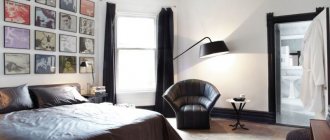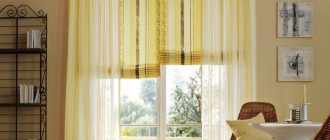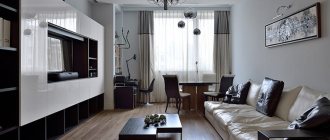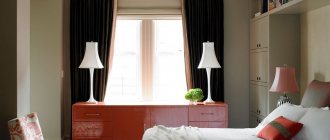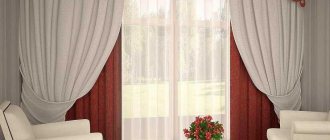Curtains in the Provence style are a wonderful decoration for windows that can create coziness in a room for any purpose and bring the serenity of the French province to the atmosphere.
Such curtains will fit into the interior space of the living room, bedroom, and kitchen.
They will bring a note of peace to urban housing and emphasize the originality of a country cottage.
Main features of the style
The style of Provence began to take shape in the 17th century, when everyone got bored with the heavy and cumbersome urban classicism. People began to look for silence, tranquility and tranquility, and found it far from the city in the countryside. How could you resist the azure sky, fragrant lavender fields and warm playful sun rays?
Provence can be very diverse, but it always has common features. The finished interiors are so expressive that they are unmistakably recognizable even by people far from the world of design. You will need delicate pastel colors, natural fabric, natural textures, small floral and plant motifs, as well as all kinds of decor.
In Provence, handmade and exclusive items are valued, so embroidered curtains, homemade tiebacks, carved cornices, forged jewelry, aged fittings and other attributes will come in handy here. And of course – soft and calm forms, without sharp or deliberately rough details.
Types of curtains for Provence
Now there are many different types of curtains, in addition to ordinary hanging curtains. You can fit almost any of them into Provence, because here the textiles themselves, colors and decorations are in the foreground. We offer you several interesting options!
Roman curtains
If you don’t have much space in your room and you don’t want to clutter it with bulky pieces of fabric, compact rolls are your choice. Roman blinds fit tightly to the window, protect well from the sun and take up almost no space. And on the reverse side you can make a blackout lining for the bedroom, children's room or too sunny kitchen.
Curtains-cafe
Fans of unconventional solutions will be pleased with cafe curtains, in which the cornice is attached right in the middle of the window. This is not the most common option, so you will certainly surprise your family and friends. Such curtains themselves create an atmosphere of comfort, provide uniform diffused light, and also look light and airy.
French curtains
What could complement the original French Provence more organically and naturally, if not the same French curtains. The canvases run down along the window and are gathered into light decorative folds along the entire length. Graceful round waves will elegantly complement the interior, and at the same time bring a festive atmosphere to it.
Priscilla curtains
In addition to ordinary curtains, you can make elegant priscilla curtains from two canvases. To do this, they are connected at the top and spread apart at the ends to the sides - you get a kind of crossed curtains. But don’t take too heavy and dense fabric for them - it will turn out too bulky and dark.
Italian curtains
Another way to use banal curtains is to make them non-sliding. Italian curtains do not mix along the cornice, and the window opens due to tiebacks and side holders. In Provence, they are good because they go well with lambrequins, tassels, hinges and other decorative elements.
Mounting methods
First, let's look at roller blinds - they are attached according to the same principle - close to the window. Guides or cords pass through the canvas in order to unfold, fold or fold it. Smooth Roman blinds also have a weighting material sewn into them at the bottom, and some models can be controlled using a remote control.
Standard techniques for vertical, free-hanging curtains are clips, rings or grommets. The first ones are more convenient because they are easier to take off and put on for washing. But the latter are evenly sewn into the curtain itself and form neat, uniform folds even on heavy fabrics.
Provence gravitates towards decorative solutions: braid, bows, all kinds of ties. Therefore, you can attach the curtains using ties or ready-made loops. For thin tulle and decorative lace curtains, the conventional drawstring method is suitable - and by the way, it is the quietest.
Which fabric to choose?
Natural textiles with expressive textures suit Provence, but there are nuances. When choosing curtains, consider where exactly they will be used, because the conditions in the bedroom, children's room and living room are fundamentally different. Let's look at the main features of each type!
Natural fabrics
Cotton, linen, wool and even silk are something you can’t go wrong with in Provence. They are absolutely environmentally friendly, beautiful and breathable, and a healthy microclimate reigns in such a room. But natural textiles are always more difficult to care for: they tolerate constant washing less well, wrinkle, and wear out faster. Although now there are special impregnations that compensate for at least some of the problems.
Synthetic fabrics
Synthetics are always of artificial origin, so it is more difficult to talk about naturalness and ecology. Basically these are different types of polyester in different processing. It is stronger, much more unpretentious, easy to wash, does not wrinkle, does not absorb odors, is better painted in any color and can withstand intensive use. But synthetics are less breathable, become electrified and can easily catch fire.
Blended fabrics
Manufacturers have managed to combine the advantages of natural fabrics with the strength of synthetic fibers. Blended textiles include almost all popular types of interior textiles - modern velvet, artificial silk, organza, jacquard. The characteristics of a particular fabric are determined by its composition and weaving, so be sure to study the label.
Is it possible to create Provence style curtains with your own hands?
Before you start creating this masterpiece, you must first understand what is the difference between this kind of curtains and simple models.
Firstly, when creating them, the use of synthetic fabrics is strictly prohibited. Fabrics for Provence curtains always mean exclusively natural fabrics, such as cotton or chintz.
It is also allowed to use various canvases made with your own hands.
It is not advisable to use fabrics with various satin tints or with some kind of shine for work, since they only give off darkness.
Secondly, Provence curtains in the interior are always a light color scheme. It doesn’t have to be white, but soft lavender or light green would be a great option.
Thirdly, curtains in the Provence living room look especially beautiful if they are correctly complemented with various folds, as well as beautiful lace.
Fourthly, the main purpose of this type of curtain is to exclusively highlight a truly beautiful interior. For these purposes, it is best to choose a floral pattern, twisted olive branches or, for example, a cage.
Drawings and colors
Provence is always a restrained, light and delicate color scheme. All shades are bleached and muted, as if bleached by the sun. But this has a big plus - they can easily be combined with each other, with white, black and wood trim.
Floral curtains
A single-color fill in Provence is not a frequent guest, because the whole style is based on deliberate decorativeness and even “puppetry”. It will be ideally complemented by floral motifs - both large buds and small, barely noticeable patterns. Let them be combined with wall fragments, decorative pillows, bedspreads or panels.
Curtains with birds and animals
If you are bored with floral and plant motifs, turn to wild fauna. Just instead of photo printing and deliberate realism, choose stylized images. For inspiration, use pastel or oil drawings, as well as the works of the impressionists.
Curtains with geometric pattern
Although strict expressive geometry is not characteristic of elegant Provence, some of its elements will look very useful here. Pay special attention to checkered or polka dot curtains. Vertical stripes visually raise the ceilings, and horizontal stripes visually enlarge the window opening.
Appearance Features
Despite the simplicity of the style, decorating windows with Provence curtains requires compliance with certain rules, namely:
- Use of exclusively natural materials;
- Simplicity and sophistication of cut;
- Calm range of colors;
- It is possible to use materials with floral patterns. The style allows for a small check in a white-red or white-blue color combination, as well as a vertical stripe.
There are no special requirements for the design of Provence curtains. These can be either classic models, English or Roman versions.
Curtains with hinges and eyelets are perfect. To add ergonomics, parallel use of pleated window decorations or roll-type products is allowed.
The main thing is the absence of rough drapery, the airiness of the design.
In order to obtain an original space, Provence curtains in the interior are often decorated with exclusive decor: ruffles, bows, lambrequins, frills. Decorative elements are often made in a striking palette of shades.
The highlight will be jewelry created with your own hands.
How to combine correctly?
Textiles are one of the most important components of all rustic interiors. This is not a separate decoration, but a full-fledged functional element. Therefore, it is logical that curtains, which inevitably attract attention, need to be correctly combined with other details of the decor.
Curtains with furniture
Curtains in the Provence style can be interestingly combined with upholstery of upholstered furniture, using similar colors or motifs. Some elements go well with decorative pillows, bedspreads or kitchen textiles. And don’t forget to pay attention to the cornice so that it matches the cabinets, shelving and furnishings in general.
Curtains with wallpaper
The main rule is not to choose curtains that match the wall covering, otherwise the room will be too monotonous. Even modest minimalism requires accents, let alone Provence! But if you want to use similar colors, then leave a difference of at least a few tones - and it’s better that the curtains are darker.
Combination of different types of curtains
You can create entire decorative compositions from different types of curtains. This is a classic combination of light tulle with thick curtains, and several different types of curtains from the same fabric in different areas of the room. There are also functional duets: for example, Roman blackout fabric at night with light French organza curtains during the day.
Selection of fabrics and colors for Provence curtains
Provence is close to the natural style, which means the materials for the curtains should be made from natural fiber. Curtains made of linen, cotton, cambric or chintz are something that can reflect the entire rustic motif. Heavy satin, silk or brocade would be inappropriate here.
When choosing a pattern for Provence curtains, you need to be careful and follow certain tips.
- A large overlay pattern is a big step, so weigh the pros and cons of it. As with a multi-colored geometric print, a large pattern is best used for a spacious kitchen with plain furniture and other finishes.
- For a small room, curtains with small floral or geometric patterns, as well as plain ones, are better suited.
- Plain walls in light colors go well with checkered and thin striped curtains; a floral print would also be appropriate. If the wallpaper in the room is “Provence” with a pattern, then opt for plain curtains. Snow-white curtains create a cold atmosphere; it is better to refrain from such a choice.
If the pattern is chosen correctly, both Roman and Austrian curtains can serve as Provençal curtains.
See the photo for a variety of colors for Provencal curtains.
Curtain decor
Provence allows you to decorate your favorite curtains with absolutely everything your heart desires. So if you have long been tired of monotonous minimalism, it’s time to think about folds, draperies and flounces. Use fringe at the bottom, tassels on the tiebacks, and a neat lambrequin or wide braid on top. Even functional fittings in Provence are a real decoration if ordinary rings or clips are replaced with aged bronze.
Curtains in Provence style in the interior - photo
Provence is a very universal style that is equally good in the bedroom, in the living room, and in the bathroom. Therefore, curtains will have to be selected for different tasks. Watch and get inspired!
Provence style curtains for the kitchen
Here, safety and functionality are at the forefront, so avoid overly bulky or bulky structures in the work area. Roman blinds or cafe curtains will fit perfectly here, but not airy tulle that flies apart at the slightest gust of wind. Choose synthetic or mixed fabrics - they are more resistant to odors, grease and stains.
Curtains in Provence style for the living room (hall)
There are few places where you can let your imagination run wild as much as in the living room. The most complex compositions with classic curtains, priscillas and French curtains would be appropriate here. Feel free to hang lambrequins, tassels, bows, tiebacks and other decorations.
Provence style curtains for the bedroom
Ideal conditions for healthy sleep are the main task when decorating a bedroom with a modern rhythm of life. Choose eco-friendly natural materials and thick lining or even blackout. Roman and Italian curtains are appropriate here, as well as any other models that allow you to completely isolate yourself from the outside world.
Curtains in Provence style for a children's room
Do not overuse decor and potentially dangerous elements on the window in the children's room. Make sure that your child does not manage to climb up the curtains or accidentally knock over the curtain rod. Pay attention to all roller models, French or Austrian curtains and others that can be completely rolled up.
Provence style curtains for the bathroom
If you are lucky enough to have a window in the bathroom, choose curtains that match the rest of the textiles. Maintain a single color scheme, repetition of patterns and other motifs. Don't use fabrics that are too bulky or thick, because they will always be damp and attract dust.
Provence style curtains for a balcony or loggia
On the one hand, you can create any interesting compositions on wide windows. On the other hand, it is important to maintain a balance so that the curtains are not too bulky simply because of the amount of fabric. Choose materials that breathe and do not fade in the sun - and you can calmly ventilate even on a hot summer day.
Main features of the style
For the correct approach to choosing curtains for a living room in the Provence style, you need to get acquainted with its characteristic features. Residents of the southern villages of France enjoyed the nature that surrounded them constantly. Lavender fields, fresh sea air, natural products and raw materials all gave people love and joy for life. The people living in the provinces were not rich, so they built houses using improvised means on their own; their housing was not at all like city apartments. Provence in the interior of the living room is filled with the lightness and unobtrusiveness that nature itself laid in it.
Provence style in its original form
Thanks to the following features, it differs from other trends and remains popular.
- Eco-materials for finishing walls and floors
- Natural textiles for furniture and curtains
- An abundance of textile decor: pillows, tablecloths, napkins, chair covers.
- Interior design in light colors, due to which the space visually expands and the room becomes bright.
- Floral designs and embroideries on decorative elements.




